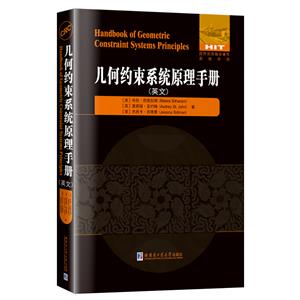扫一扫
关注中图网
官方微博
本类五星书更多>
-
>
宇宙、量子和人类心灵
-
>
气候文明史
-
>
南极100天
-
>
考研数学专题练1200题
-
>
希格斯:“上帝粒子”的发明与发现
-
>
神农架叠层石:10多亿年前远古海洋微生物建造的大堡礁
-
>
声音简史
几何约束系统原理手册:英文 版权信息
- ISBN:9787576709414
- 条形码:9787576709414 ; 978-7-5767-0941-4
- 装帧:平装-胶订
- 册数:暂无
- 重量:暂无
- 所属分类:>>
几何约束系统原理手册:英文 内容简介
本手册旨在作为当前使用的基本数学和计算工具、方法和结果的切入点。它诞生于对包含核心原理和结果的单一来源的持续需求,初学者和专家(从刚刚开始进行研究的研究生到对应用感兴趣的代数几何学家,再到寻求制造一批自主代理的机器人专家)都可以理解。希望本书可以成为读者掌握GCS研究中的概念、方法和结果的有效工具。
本书的目的是为那些希望熟悉基础知识的人以及希望在广阔的领域中确定具体结果或方法的专家提供资源,旨在将读者从一般的代数几何方法带入更专业的包含组合分析和高效算法的语境之中。章节按所使用的主要方法进行分组,希望读者能够找到***他们的专业知识的材料。
几何约束系统原理手册:英文 目录
Foreword
Preface
Contributors
1 Overview and Preliminaries
Meera Sitharam and Troy Baker
1.1 Introduction
1.1.1 Specifying a GCS
1.1.2 Fundamental GCS Questions
1.1.3 Tractability and Computational Complexity
1.2 Parts and Chapters of the Handbook
1.2.1 Part I:Geometric Reasoning Techniques
1.2.2 Part II:Distance Geometry,Configuration Space,and Real Algebraic Ge-ometry Techniques
1.2.3 Part III:Geometric Rigidity Techniques
1.2.4 Part IV:Combinatorial Rigidity Techniques
1.2.4.1 Inductive Constructions
1.2.4.2 Body Frameworks
1.2.4.3 Body-Cad,and Point-Line Frameworks
1.2.4.4 Symmetric and Periodic Frameworks and Frameworks under Polyhedral Norms
1.2.5 Missing Topics and Chapters
1.3 Terminology Reconciliation and Basic Concepts
1.3.1 Constrainedness
1.3.2 Rigidity of Frameworks
1.3.3 Generic Rigidity of Frameworks
1.3.4 Approximate Degree-of-Freedom and Sparsity
1.4 Alternative Pathway through the Book
I Geometric Reasoning,Factorization and Decomposition
2 Computer-Assisted Theorem Proving in Synthetic Geometry Julien Narboux,Predrag Jani?i?,and Jacques Fleuriot
2.1 Introduction
2.2 Automated Theorem Proving
2.2.1 Foundations
2.2.2 Nondegenerate Conditions
2.2.3 Purely Synthetic Methods
2.2.3.1 Early Systems
2.2.3.2 Deductive Database Method,GRAMY,and iGeoTutor
2.2.3.3 Logic-Based Approaches
2.2.4 Semisynthetic Methods
2.2.4.1 Area Method
2.2.4.2 Full-Angle Method
2.2.4.3 Vector-Based Method
2.2.4.4 Mass-Point Method
2.2.5 Prover s Implementations and Repositories of Theorems
2.3 Interactive Theorem Proving
2.3.1 Formalization of Foundations of Geometry
2.3.1.1 Hilbert's Geometry
2.3.1.2 Tarski’s Geometry
2.3.1.3 Axiom Systems and Continuity Properties
2.3.1.4 Other Axiom Systems and Geometries
2.3.1.5 Meta-Theory
2.3.2 Higher Level Results
2.3.3 Other Formalizations Related to Geometry
2.3.4 Verified Automated Reasoning
3 Coordinate-Free Theorem Proving in Incidence Geometry
Jürgen Richter-Gebert and Hongbo Li
3.1 Incidence Geometry
3.1.1 Incidence Geometry in the Plan e
3.1.2 Other Primitive Operations
3.1.3 Projective Invariance
3.2 Bracket Algebra:Straightening,Division,and Final Polynomials
3.2.1 Bracket Algebra and Straightening
3.2.2 Division
3.2.3 Final Polynomials
3.3 Cayley Expansion and Factorization
3.3.1 Cayley Expansion
3.3.2 Cayley Factorization
3.3.3 Cayley Expansion and Factorization in Geometric Theorem Proving
3.3.4 Rational Invariants and Antisymmetrization
3.4 Bracket Algebra for Euclidean Geometry
3.4.1 The Points I and J
3.4.2 Proving Euclidean Theorems
4 Special Positions of Frameworks and the Grassmann-Cayley Algebra
Jessica Sidman and William Traves
4.1 Introduction:the Grassmann-Cayley Algebra and Frameworks
4.2 Projective Space
4.2.1 Motivation
4.2.2 Homogeneous Coordinates and Points at Infinity
4.2.3 Equations on Projective Space
4.2.4 Duality Between Lines and Points in IP2
4.2.5 Grassmannians and Plücker Coordinates
4.2.6 More About Lines in 3-space
4.3 The Bracket Algebra and Rings of Invariants
4.3.1 Group Actions and Invariant Polynomials
4.3.2 Relations Among the Brackets
4.4 The Grassmann-Cayley Algebra
……
II Distance Geometry, Real Algebraic Geometry, and Configuration Spaces
III Geometric Rigidty
IV Combinatorial Rigidity
Preface
Contributors
1 Overview and Preliminaries
Meera Sitharam and Troy Baker
1.1 Introduction
1.1.1 Specifying a GCS
1.1.2 Fundamental GCS Questions
1.1.3 Tractability and Computational Complexity
1.2 Parts and Chapters of the Handbook
1.2.1 Part I:Geometric Reasoning Techniques
1.2.2 Part II:Distance Geometry,Configuration Space,and Real Algebraic Ge-ometry Techniques
1.2.3 Part III:Geometric Rigidity Techniques
1.2.4 Part IV:Combinatorial Rigidity Techniques
1.2.4.1 Inductive Constructions
1.2.4.2 Body Frameworks
1.2.4.3 Body-Cad,and Point-Line Frameworks
1.2.4.4 Symmetric and Periodic Frameworks and Frameworks under Polyhedral Norms
1.2.5 Missing Topics and Chapters
1.3 Terminology Reconciliation and Basic Concepts
1.3.1 Constrainedness
1.3.2 Rigidity of Frameworks
1.3.3 Generic Rigidity of Frameworks
1.3.4 Approximate Degree-of-Freedom and Sparsity
1.4 Alternative Pathway through the Book
I Geometric Reasoning,Factorization and Decomposition
2 Computer-Assisted Theorem Proving in Synthetic Geometry Julien Narboux,Predrag Jani?i?,and Jacques Fleuriot
2.1 Introduction
2.2 Automated Theorem Proving
2.2.1 Foundations
2.2.2 Nondegenerate Conditions
2.2.3 Purely Synthetic Methods
2.2.3.1 Early Systems
2.2.3.2 Deductive Database Method,GRAMY,and iGeoTutor
2.2.3.3 Logic-Based Approaches
2.2.4 Semisynthetic Methods
2.2.4.1 Area Method
2.2.4.2 Full-Angle Method
2.2.4.3 Vector-Based Method
2.2.4.4 Mass-Point Method
2.2.5 Prover s Implementations and Repositories of Theorems
2.3 Interactive Theorem Proving
2.3.1 Formalization of Foundations of Geometry
2.3.1.1 Hilbert's Geometry
2.3.1.2 Tarski’s Geometry
2.3.1.3 Axiom Systems and Continuity Properties
2.3.1.4 Other Axiom Systems and Geometries
2.3.1.5 Meta-Theory
2.3.2 Higher Level Results
2.3.3 Other Formalizations Related to Geometry
2.3.4 Verified Automated Reasoning
3 Coordinate-Free Theorem Proving in Incidence Geometry
Jürgen Richter-Gebert and Hongbo Li
3.1 Incidence Geometry
3.1.1 Incidence Geometry in the Plan e
3.1.2 Other Primitive Operations
3.1.3 Projective Invariance
3.2 Bracket Algebra:Straightening,Division,and Final Polynomials
3.2.1 Bracket Algebra and Straightening
3.2.2 Division
3.2.3 Final Polynomials
3.3 Cayley Expansion and Factorization
3.3.1 Cayley Expansion
3.3.2 Cayley Factorization
3.3.3 Cayley Expansion and Factorization in Geometric Theorem Proving
3.3.4 Rational Invariants and Antisymmetrization
3.4 Bracket Algebra for Euclidean Geometry
3.4.1 The Points I and J
3.4.2 Proving Euclidean Theorems
4 Special Positions of Frameworks and the Grassmann-Cayley Algebra
Jessica Sidman and William Traves
4.1 Introduction:the Grassmann-Cayley Algebra and Frameworks
4.2 Projective Space
4.2.1 Motivation
4.2.2 Homogeneous Coordinates and Points at Infinity
4.2.3 Equations on Projective Space
4.2.4 Duality Between Lines and Points in IP2
4.2.5 Grassmannians and Plücker Coordinates
4.2.6 More About Lines in 3-space
4.3 The Bracket Algebra and Rings of Invariants
4.3.1 Group Actions and Invariant Polynomials
4.3.2 Relations Among the Brackets
4.4 The Grassmann-Cayley Algebra
……
II Distance Geometry, Real Algebraic Geometry, and Configuration Spaces
III Geometric Rigidty
IV Combinatorial Rigidity
展开全部
几何约束系统原理手册:英文 作者简介
米拉·西塔拉姆(Meera Sitharam),美国人,目前是佛罗里达大学计算机与信息科学与工程系的副教授。她在威斯康星大学麦迪逊分校获得了博士学位。
书友推荐
- >
烟与镜
烟与镜
¥18.3¥48.0 - >
【精装绘本】画给孩子的中国神话
【精装绘本】画给孩子的中国神话
¥18.6¥55.0 - >
自卑与超越
自卑与超越
¥13.7¥39.8 - >
名家带你读鲁迅:朝花夕拾
名家带你读鲁迅:朝花夕拾
¥10.5¥21.0 - >
中国历史的瞬间
中国历史的瞬间
¥16.7¥38.0 - >
推拿
推拿
¥12.2¥32.0 - >
伊索寓言-世界文学名著典藏-全译本
伊索寓言-世界文学名著典藏-全译本
¥6.7¥19.0 - >
巴金-再思录
巴金-再思录
¥15.7¥46.0
本类畅销
-
普林斯顿概率论读本
¥87.6¥139 -
TUKEY统计学讲义:数据分析与回归
¥79.7¥119 -
TUKEY统计学讲义:探索性数据分析
¥86.4¥129 -
怎样解题
¥17.8¥29 -
不良情绪应急处理包--孤独感
¥12.9¥30 -
不良情绪应急处理包--精神内耗
¥12.9¥30
浏览历史
简朴至真 精雕达理:我的教育人手记
¥18.0¥50.0Python贝叶斯深度学习
¥59.3¥79.8高速数字系统设计与分析教程——基础篇
¥50.0¥89.0一点五维的巴赫音乐、科学和历史(精装)
¥43.8¥62.0国际金融学
¥22.4¥32.0

















